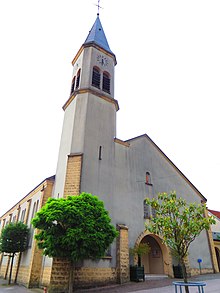Woustviller
| Woustviller | ||
|---|---|---|

|
|
|
| region | Grand Est | |
| Department | Moselle | |
| Arrondissement | Sarreguemines | |
| Canton | Sarralbe | |
| Community association | Sarreguemines Confluences | |
| Coordinates | 49 ° 5 ' N , 7 ° 1' E | |
| height | 209-275 m | |
| surface | 10.97 km 2 | |
| Residents | 3,175 (January 1, 2017) | |
| Population density | 289 inhabitants / km 2 | |
| Post Code | 57915 | |
| INSEE code | 57752 | |
 Mairie Woustviller |
||
Woustviller (1801 still with the spelling Woustveiller ; German Wustweiler ) is a French commune with 3,175 inhabitants (as of January 1, 2017) in the Moselle department in the Grand Est region (until 2015 Lorraine ). It belongs to the Sarreguemines arrondissement and the Sarreguemines Confluences municipality .
geography
The municipality of Woustviller in northeast Lorraine is located immediately southwest of the city of Sarreguemines and therefore not far from the border with Saarland . The municipal area of almost 11 km² is traversed by the Dorfbach , which has been dammed into several fish ponds in the municipal area and drains via the Altwiesenbach to the Saar . Woustviller is surrounded by three larger forest areas, which include parts of the Forêt de Hambach and the Forêt de Sarreguemines .
Neighboring communities of Woustviller are Ippling in the north, Sarreguemines in the northeast, Neufgrange in the east, Hambach in the southeast, Grundviller in the south, Ernestviller in the west and Hundling in the northwest.
history
In the area of today's municipality of Woustviller there were originally three hamlets: Hildemannsweiler or Wilre or Hangweiler, Berg or Bergweiler and Brühl . Hildemannsweiler was first mentioned on April 11, 1179 in a document from the Premonstratensian Abbey in Wadgassen . During the Thirty Years War , the hamlets, in which a total of about 150 inhabitants lived, were destroyed. Only the church and the rectory remained and served as the core of the new village of Wustweiler , which was gradually repopulated . Field names such as Hanweiler Ackerfeld, Hanweiler Garten, Wies Hanweiler, Kapellenbruhl, Wasbruhlberg, Wasbruhlwies or Wasbruhlwald still remind us of the existence of the earlier settlements . In 1685 there were 60 people living in the village again, in 1698 there were 150 inhabitants and at the beginning of the French Revolution there were already 365 inhabitants.
A faience factory was set up in nearby Saargemünd in 1790 and a ceramic tile factory in 1860. Many employees from Woustviller, who could no longer support the local agriculture, also worked there. In 1861 Woustviller had 618 inhabitants. In 1866 a new school was built in the village. After the Franco-Prussian War and the resulting affiliation of Lorraine to Germany, the population steadily decreased because many families emigrated to France or America (459 inhabitants in 1916). In 1885 a distillery was established in Woustviller, which made brandy from potatoes. Agriculture shaped the village until well into the middle of the 20th century. There were also blacksmiths, millers, bricklayers, joiners, lumberjacks, weavers, basket weavers and potters. Many women made ready-to-wear articles from home, including hats for a company in Sarre-Union .
The construction of the church Woustvillers began in 1807. A year later it was consecrated to John the Baptist (Jean le Baptiste), the patron saint of the community. During the First World War, the church bells were melted down for ammunition production. In September 1939 the population was evacuated to Abzac in the Charente department and brought back a year later by the German authorities. In November 1944 the tower of the church was destroyed by the advancing Americans. The Woustviller, which was 70% in ruins after the end of the Second World War, was rebuilt by 1959, the church was restored by 1965.
From the 1970s, two extensive residential areas emerged north and south-west (Chambourg) of the old village center, which mainly consist of private homes and which are five times larger than the old village in terms of area and population.
Population development
| 1962 | 1968 | 1975 | 1982 | 1990 | 1999 | 2007 | 2017 | ||
| 574 | 736 | 1107 | 1970 | 2875 | 3311 | 3075 | 3175 | ||
| Sources: Cassini and INSEE | |||||||||
Woustviller has been able to record strong population growth since the 1960s due to the proximity to new, large industrial parks that were created on the national road connections and the provision of inexpensive building land.
Attractions
- Saint-Jean-Baptiste church, originally from 1805, after being destroyed in 1944, the church was rebuilt in 1965
- Calvary from 1762
Economy and Infrastructure
Agriculture only plays a subordinate role in Woustviller today. There are 13 farms in the community (horse and cattle breeding). The community itself is mainly the residence for many employees from the nearby companies, which include Smartville and the petrochemical plant of the Ineos group, but also companies in the ZA de Bantzenheim industrial park in the Woustviller community. These companies include the large logistics company Altrans and the company Hummer Plastiques , which produces pipes and hoses made of rubber and plastic.
National road 74 ( Sarreguemines - Nancy - Toul - Dijon ) runs through the municipality of Woustviller and crosses the heavily frequented national road 61 ( Strasbourg - Phalsbourg - Sarre-Union - Saarbrücken ) northeast of the municipality . Four kilometers south of the community there is a connection to the Paris-Strasbourg motorway (connection Sarreguemines ). The next larger train station is in neighboring Sarreguemines.
Parish partnership
Woustviller has been in partnership with Wustweiler of the same name since 1996 , a part of the Saarland community of Illingen .
supporting documents
- ↑ toponym on cassini.ehess.fr
- ↑ Woustviller on cassini.ehess.fr
- ↑ Woustviller on insee.fr
- ↑ Farms on annuaire-mairie.fr (French)


